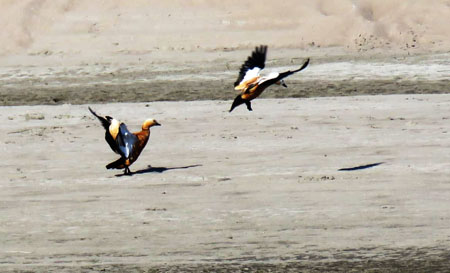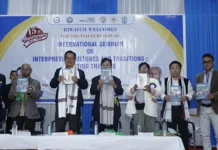[ Prafulla Kaman ]
PASIGHAT, Dec 10: The glory days of Daying Ering Memorial Wildlife Sanctuary (DEMWS) in East Siang district are on their way back, thanks to intensified patrolling in and around the sanctuary.
“Apart from intensified patrolling, the forest officials are constantly mobilizing the people of the fringe areas to protect the wildlife sanctuary, which is famous for its rich biodiversity,” said Divisional Forest Officer (Wildlife) Tasang Taga.
The wildlife officials during a recent survey sighted many wild animals, including hog deer, sambar, wild boar, buffaloes, etc. Various birds and reptile species, and aquatic animals were also sighted thriving in the natural vegetation inside the sanctuary.
Reportedly, the forest officials also observed pugmarks of leopards and the Royal Bengal tiger on the sandbars inside the sanctuary.
In March this year, leading wildlife NGO Aranyak, based in Guwahati (Assam), conducted camera trapping in the sanctuary and traced the movement of hog deer, sambar, hares, wild boars, wild buffalo, elephants and primates in the sanctuary.
Movement of some carnivorous animals, including big cat species, was also recorded during their survey.
Taga informed that the NGO conducted a survey on animal diversity in their natural habitats in the state, venturing into deep jungles and riverine islands of the region and conducting a systematic study on suitable habitats for the wild beasts. It later submitted its report to a wildlife expert team for analysis.
Officials from the WWF had also conducted a camera trapping survey in 2013 and traced the survival of many wild animals in the sanctuary.
On the other hand, winter migratory birds, including the ruddy shelduck (Tadorna ferruginea), the great cormorant (Phalacrocorax carbo) and many other water birds have started to arrive at the water bodies of the wildlife sanctuary since the first week of December, attracting special attention of the wildlife officials and nature lovers.
The migratory birds used to arrive in the area during January or early February every year, but these winged guests were not seen in the last couple of years due to water pollution.
Located 8 kms east of Pasighat town, the wildlife sanctuary provides a model habitat for wild animals and birds. It is considered a significant factor in restoring the ecological balance of the region.
Researchers, students and tourists from different parts of the country and abroad regularly visit the sanctuary to witness its rich birdlife during winter.





